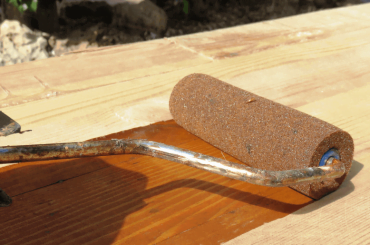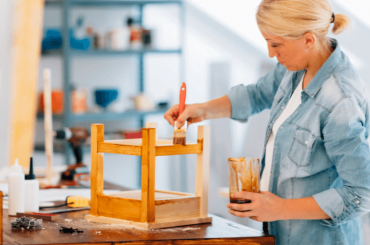Can You Paint Pressure Treated Wood? The answer is yes, you can paint pressure-treated wood!
In fact, it’s a great idea to do so, as it will help protect the wood from weathering and extend its life. But there are a few things you need to know first.
In this post, we’ll share tips for painting pressure-treated wood and show you how to get the best results.
We’ll also explore some of the pros and cons of doing so and what is the risk associated with it. Read on to find out more!
Can You Paint Pressure Treated Wood?
Yes, you can paint pressure-treated wood, but it is not necessary. Pressure-treated wood is already resistant to rot and decay, so the paint does not provide any additional protection.
However, if you want to change the color of the wood or simply want to freshen it up, painting is an option.
But it is important to note that the type of paint you use will be different than what you would use on regular wood. Because pressure-treated wood has been chemically treated, you will need to use a particular type of paint that is designed for this purpose.
Be sure to follow the directions on the label carefully to get the best results.
What is pressure-treated wood and why is it used for outdoor projects? Pressure-treated wood is wood that has been treated with chemicals to protect it from rot, insects and other damage. The process of pressure treating wood helps to extend the life of the wood, making it an ideal material for outdoor projects.
Pressure-treated wood is also popular for building structures like sheds and gazebos. Pressure-treated wood is most commonly used for decks, porches and other outdoor projects because it is resistant to rot and decay.
The pressure-treatment process forces a chemical preservative deep into the wood fibers, making the lumber more durable and longer lasting. Pressure-treated wood can last up to 40 years before it needs to be replaced.
Pros & Cons Of Painting Pressure-Treated Wood
Here are the pros and cons of painting pressure-treated wood.
Pros
- It can help protect the wood from weathering and pests.
- It can give the wood a new look.
- It can extend the life of the wood.
- Painting pressure-treated wood can be a great way to customize your outdoor space.
- Makes the wood easier to clean.
Cons
- Paint can chip and peel over time, which can be a maintenance issue.
- You will need to use a primer specifically designed for pressure-treated wood before painting.
- Pressure-treated wood is already treated with chemicals, so it is not necessary to add more chemicals by painting it.
- Requires more maintenance than non-painted pressure-treated wood.
- The paint may not adhere well to the pressure-treated wood.
How do paint pressure-treated wood for the best results?
- The first step is to sand the surface of the pressure-treated wood to help remove any rough edges or splinters.
- When painting pressure-treated wood, it is important to wait at least 30 days after the initial treatment before applying paint or primer. This allows the chemicals in the pressure-treated lumber to fully cure and off-gas
- Next, you will apply a primer to the wood. This will help the paint to better adhere to the surface and also provide a base layer of protection.
- Once the primer is dry, you can begin painting your pressure-treated wood. It is best to use paint specifically designed for outdoor use on pressure-treated wood.
- Paint in thin coats, allowing each coat to dry completely before adding another.
- Use a high-quality brush or roller to apply the paint evenly to avoid streaks or lap marks.
- After the paint has dried, you can apply a sealant to help protect it from weathering and wear. This will also give it a nice shine.
Tips for prepping the surface and applying the paint
1) Clean the surface
Any dirt or grime on the surface will show through the paint, so it’s important to make sure the area is clean before you get started.
You can use a mild soap and water solution to clean the surface or you can rent a power washer from your local hardware store to quickly remove any stubborn dirt or grime.
2) Repair any cracks or holes
Once the surface is clean, take the time to repair any cracks or holes that might be present. These can also show through the paint, so it’s best to deal with them before you start painting.
Use a putty knife or caulking gun to fill in any cracks or holes, then use sandpaper to smooth out the area until it’s flush with the rest of the surface.
3) Prime the surface
After the surface is clean and repaired, it’s time to prime it. This will help the paint to adhere better and will also give you a more even finish.
Use a brush or roller to apply a primer specifically designed for use on pressure-treated wood.
4) Apply the paint
Use a paintbrush to apply the paint evenly to the surface of the wood. Allow the paint to dry completely before using or handling the painted surface.
Apply a second coat of paint if desired or necessary for better coverage.
Are there any risks associated with painting pressure-treated wood and if so, what can be done to minimize them?
Yes, there are some risks associated with painting pressure-treated wood.
- The paint can chip and flake off, exposing the wood to moisture and causing it to rot.
- The paint can also trap moisture in the wood, leading to warping and cracking.
- If the paint is not applied properly, it can peel and bubble.
- Pressure-treated wood is often treated with chemicals that can be harmful to humans and the environment.
- These chemicals can leach out of the wood and into the soil, water and air.
- Inhaling the fumes from pressure-treated wood can cause respiratory problems and irritate skin contact. If you are pregnant, exposure to pressure-treated wood chemicals can also harm your unborn child.
- Another risk is that the chemicals in the pressure-treated wood may react with the paint, causing it to discolor or fade over time.
There are a few things you can do to minimize the risks associated with painted pressure-treated wood.
- First, be sure to wear gloves and a respirator to protect yourself from the chemicals in the wood.
- Second, use high-quality paint that is designed for use on pressure-treated wood. This will help to ensure that the paint will not chip or peel off of the wood.
- Third, apply the paint in a well-ventilated area.
- Finally, be sure to follow all of the manufacturer’s instructions carefully to ensure that you are using the product correctly.
FAQs – Painting Pressure Treated Wood
What kind of paint do you use on pressure-treated wood?
The type of paint you use on pressure-treated wood will depend on the location of the wood and the level of exposure to the weather.
For example, if the wood is in a shady area with little exposure to sunlight and rain, you may be able to get away with using cheaper latex paint.
If the wood is in a sunny, exposed area, you’ll need to use a more durable acrylic or oil-based paint.
You should also use paint that is specifically designed for pressure-treated wood. This type of paint will be able to withstand the elements and wear and tear better than other types of paint.
What happens if you paint pressure-treated wood?
- If you paint pressure-treated wood, it will still be protected from rot and decay.
- If you paint pressure-treated wood, the paint will act as a barrier against moisture and insects.
- Pressure-treated wood that is painted may also require more frequent cleaning and staining.
However, it is important to note that painting pressure-treated wood will void the warranty and the paint will act as a barrier to the CCA treatment, so it will need to be reapplied more often.
Is it good to paint pressure-treated wood?
Yes, it is perfectly fine to paint pressure-treated wood. Painting or staining pressure-treated wood can help extend its life and protect it from the elements.
Just be sure to use a quality exterior paint or stain that is designed for use on pressure-treated wood.
Final Words
Yes! You can paint pressure-treated wood. But there are some things you need to keep in mind.
Be sure to use a primer and high-quality exterior paint. And, if you live in an area with lots of rain or snow, be prepared to repaint your project more often than if it’s located in a drier climate.
By following these tips, you can enjoy a beautiful painted finish on your pressure-treated wood for years to come.



